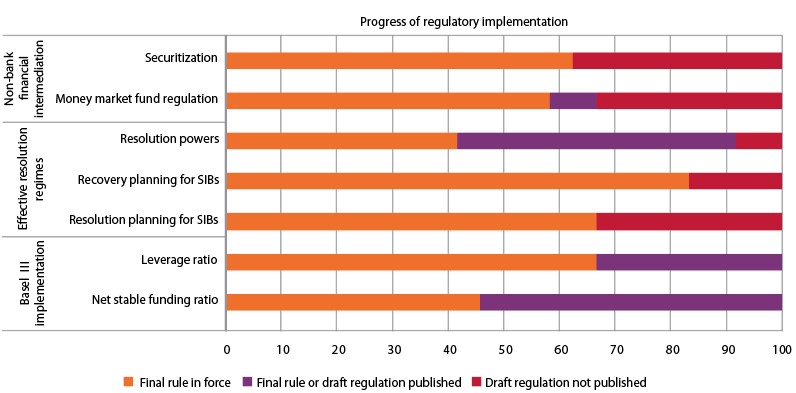The Addis Ababa Action Agenda emphasizes the importance of strengthening regulatory frameworks at all levels to further increase transparency and accountability of financial institutions, and to address the regulatory gaps and misaligned incentives in the international financial system.
Within the Addis Agenda, Member States commit to:
- Work to strengthen regulatory frameworks to increase transparency and accountability of financial institutions
- Hasten completion of the reform agenda on financial market regulation
- Address the risk created by “too-big-to-fail” financial institutions and address cross-border elements in effective resolution of troubled systemically important financial institutions
- Sustain or strengthens frameworks for macroprudential regulation and countercyclical buffers
- Assess and if necessary reduces the systemic risks associated with shadow banking, markets for derivatives, securities lending, and repurchase agreements
- Reduce mechanistic reliance on credit rating agency assessments, including in regulations; promote increased competition and avoid conflict of interest in the provision of credit ratings; support building greater transparency requirements for evaluation standards of credit rating agencies and commit to continue ongoing work on these issues, including in the United Nations
In the Addis Agenda, Member States further acknowledged that:
- When dealing with risks from large and volatile capital flows, necessary macroeconomic policy adjustment could be supported by macroprudential and, as appropriate, capital flow management measures
Latest developments
The Group of Twenty (G20) agreed to a number of financial regulatory reforms through the Financial Stability Board (FSB) in the wake of the 2008 world financial and economic crisis, with the final major policy reforms adopted by the global body of bank regulators—the Basel Committee on Banking Supervision—in late 2017. Some additional policy work remains, but most attention has now turned towards implementation of the reforms. Despite progress, implementation of the reforms is not complete and remains uneven:
- Large banks are better capitalized, less leveraged and hold more liquidity.
- Steps have been taken to address financial institutions that are considered too big to fail (TBTF).
- Insurance industry supervisory reforms, such as creating effective resolution regimes, are less advanced, while the sector is also facing new challenges from climate change.
- Derivatives markets have been another focus of regulators. The markets are now simpler and more transparent, although additional progress since 2018 has been limited.
- Regulation of non-bank financial intermediaries (NBFIs), including structured finance vehicles, investment funds, money market funds, hedge funds, broker-dealers, trust companies, and other non-bank and non-insurance lenders, has also been on the FSB agenda.
Progress of regulatory reform implementation, 2019

Source:FSB
Note: For systemically important banks (SIBs), the six European Union members of the FSB are presented as separate jurisdictions.
Total global financial assets have continued to increase since the global financial crisis. Risk in the financial sector has declined since the global financial crisis, while risk may have increased in NBFIs during the period of high global liquidity.
A remaining risk factor in the banking sector is the growth of systemically important banks’ share of global banking assets, as large banks continue to become ever larger and more complex.
The FSB is in the process of evaluating the effects of TBTF reforms for systemically important banks and will launch a public consultation in June 2020. The FSB is continuing to conduct evaluations on different aspects of the reforms. The next evaluation, to be completed by end-2021, will be on the effects of money market fund reforms. These studies are intended not only to monitor the impact of FSB reforms, but also identify possible unintended effects of the reforms.
Read more the implementation and impact of reforms, including their risk factors here.
Relevant SDG indicator